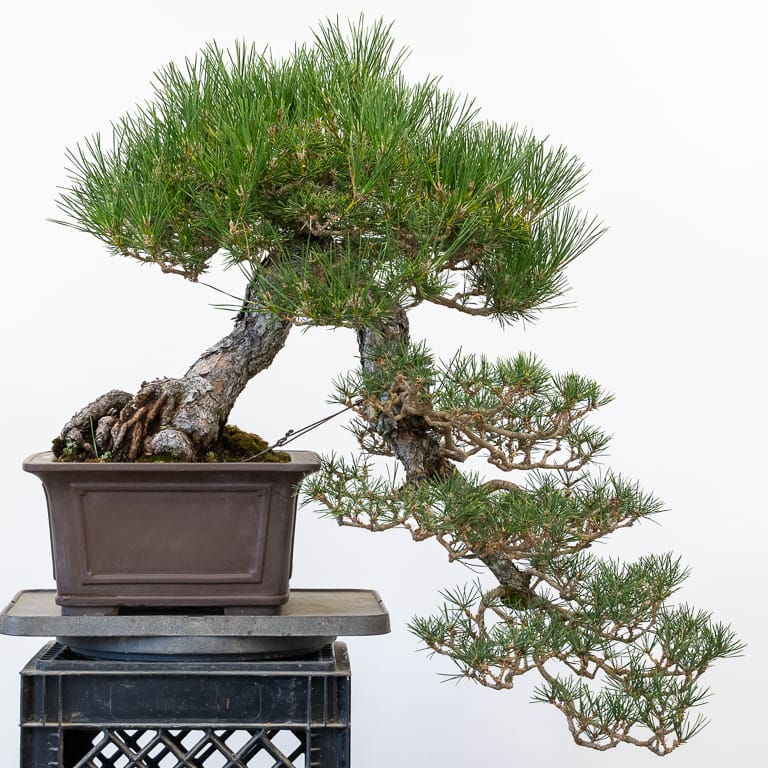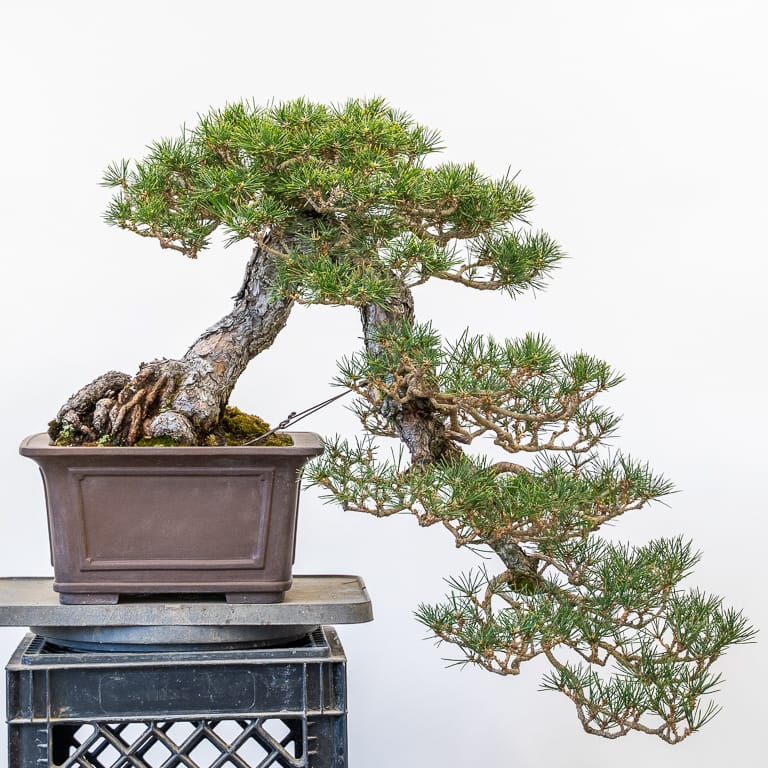Decandling is a pruning technique where spring growth is removed to stimulate a second flush of growth over summer.
The basic technique can be an effective way to produce dense foliage on black and red pines, and there are several variations that can help us balance vigor between weak and strong branches at the same time.
Today we’ll look at the most effective variation for balancing vigor: decandling a tree in stages.
As you can see in the photo below, the upper branches are fuller than the lower branches. This is natural as pines are apically dominant. In other words, pines are more likely to invest resources in branches that receive the most light – those near the top – than they are to invest in the lowest branches.

Black pine
To help the lower branches gain strength, I want to give them a head start. I’ll decandle these branches first.

After decandling the lower branches
About twelve days later, I decandled the upper branches. These branches will have twelve fewer days to produce new growth before the end of the growing season.
Twelve days may not seem like much, but it’s enough time to give the lower branches a boost and help them grow stronger.
After decandling the upper branches, I noticed that there were far more needles here than there were on the lower half of the tree. Why? Because I didn’t finish plucking the needles in fall!

After decandling the upper branches
I took a few minutes to thin the top of the tree and do some light cutback. Here’s the tree after decandling and plucking the excess needles.

After pulling needles from the upper branches – 25″ top to bottom
I’ll be sharing a few decandling case studies this season, so let me know in the comments below if there are decandling-related questions you’d like me to address. And for a full description of the decandling process, see “Decandling – an in-depth guide.”
Subscribe to Bonsai Tonight
New Posts Delivered Every Tuesday and Friday
Jean-Philippe Michot says
Thanks. do you apply the same technique for deciduous bonsais?
Jonas Dupuich says
Great question Jean-Philippe – I haven’t tried the technique on deciduous trees because they produce such strong growth. Instead, I prune the strong areas more frequently and let the weak branches grow freely until they become stronger. It’s the same idea but a different technique.
Bob Martin says
What a lovely pine! Is this work that you are doing right now in your area?
I have a Black Pine that has gotten away a bit over the years but is generally healthy. I would like to shorten some of the main branches in an effort to get some foliage closer to the trunk and to bring it back into proper perspective. Should I be doing this cutback at the same time that I am decandling or is there an advantage to waiting to cutback until the late summer/early fall. If I only decandle some of the tree and wait for fall to cut back the rest, I have it in my mind that the tree will put its energy into the area that is not decandled, forgoing the production of strong summer shoots at the decandling sites. Does this make any sense?
Jonas Dupuich says
Yes, this is work I’m doing now, and I like doing some cutback when I decandle. As for partial decandling, only decandling some of the branches and leaving others alone, the main reason for this approach is to let weak areas gain vigor. If you have questions about a specific tree, feel free to post photos to the forum and we can take a look there: https://ask.bonsaitonight.com/
Ken Roberts says
Thanks, Jonas. But I’m a little confused by the rational for this technique. It makes more sense to me to decandle the stronger shoots so that the resources they use is lessened, allowing those resources, auxin in particular, to strengthen the weaker. What am I missing here?
Jonas Dupuich says
Hi Ken – great question. Here’s another way of looking at it. I’ll be judging the results of the technique by evaluating the summer foliage at the end of the growing season, say, on November 1st. If I decandle the tree on June 1, the tree will have five months to produce new foliage. If I decandle on August 1 the tree will only have three months to grow before winter. This would result in fairly weak summer growth and the needles would be small. If I wait until October 1 to decandle, it will be too late in the growing season to expect the tree to produce much new growth before the tree slows down for winter. Based on this response, I can deduce that the earlier I cut, the stronger the summer growth will be by November 1. Likewise, the later I cut, the less growth I’ll get by November 1.
By cutting the weakest branches first, I’m giving them an advantage over branches that are cut later as they’ll have longer to mature before the tree slows down for winter.
This approach has been common practice for at least three decades in Japan and almost as long in the US. It’s incredibly effective when there are big differences in vigor between the weakest and strongest areas of a tree. When there aren’t big differences in vigor among branches or there’s no opportunity to decandle a tree over multiple days, I decandle all of the branches in a single day.
Does this help?
Ken Roberts says
Aaahhhh💡Makes sense now.
todd Morgan says
I have heard not to decandle every year, if the tree is not strong enough. do we just treat them as a single flush pine if we don’t decandle, yet don’t want too much extension? also, do we treat as single flush pine if we need to get backbudding, after the candles start to harden off? I am at that decision point now on some of my black pines, so help will be much appreciated. thank you for your site…
Jonas Dupuich says
That’s right about not decandling if the tree isn’t healthy. If I don’t decandle, I leave the tree alone until fall when I do the usual fall work of thinning and needle-plucking. Backbudding happens when the tree is healthy so I focus on making the tree healthy again so I can decandle the following year.
If you have questions about specific trees, feel free to post a photo on the forum and I can take a look!
https://ask.bonsaitonight.com/